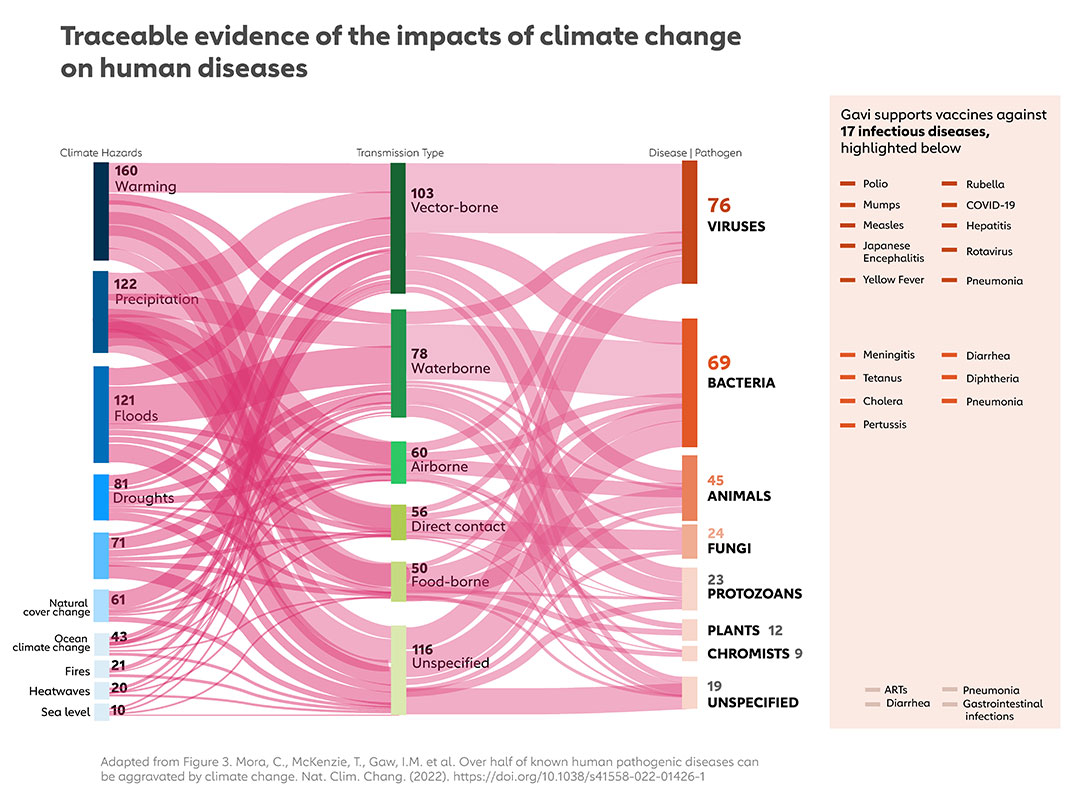Part
01
of one
Part
01
How is climate change exacerbating pathogenic diseases?
Key Takeaways
- Climate change provides improved climate sustainability for pathogen reproduction, habitat disruptions, and melting permafrost are reasons exacerbating the outbreak of pathogenic diseases.
- Warm climates accelerate the life cycle of pathogens, increasing the seasons and length of their likely exposure to humans.
- The destruction caused by floods and storm events causes wastewater passages to overflow to join natural water sources, spreading pathogen-carrying vectors that account for the increasing incidence of cholera, norovirus, and rotavirus outbreaks.
Introduction
Improved climate suitability for pathogen reproduction, habitat disruptions, and melting permafrost are or will be responsible for exacerbating the outbreak of pathogenic diseases. We have presented our findings and Research Strategy below.
Diseases Aggravated by Climate Change
- Studies indicate that about 60% of pathogenic diseases are exacerbated by the changing climate. The list of diseases aggravated by climatic hazards is below.
Improved Climate Suitability for Pathogen Reproduction
- Studies indicate that about 60% of pathogenic diseases are exacerbated by the changing climate. Warming climates at higher latitudes serve as conducive environments for pathogens to thrive. For instance, the survival and spread of viruses like Zika, hepatitis, malaria, and Dengue are boosted by warming climates at higher latitudes.
- Warm climates accelerate the life cycle of pathogens, increasing the seasons and length of their likely exposure to humans. As a result, this enhances the vector-pathogen interaction.
- According to a study by Cheng et al. in 2019, climate-induced changes "alter fungal survivability and infectivity as well as host susceptibility, leading to new disease outbreaks" with temperature as a major driver of many vector-borne infections. Additionally, favorable conditions occasioned by climate change enhance the reproduction and emergence of new virulent infections, posing significant health concerns and additional research.
- For example, ocean warming and heavy precipitation influenced by the climate facilitate pathogen growth caused by reduced ocean salinity and serve as suitable environments for Vibriosis outbreaks. This accounts for the main reason why Vibriosis outbreaks emerged in unlikely locations.
- Existing have established a connection between pathogen growth and infection with temperature changes. Thus, "not only will climate change aggravate existing diseases, [but] it could also create evolutionary pressures for more heat-resistant pathogens that might be able to survive one of our body’s main defense mechanisms: fever."
Disruption to Habitats
- Climate events like drought, heatwaves, warming, bushfires, floods, storms, and land degradation, among others, in their disruptive episodes, carry along pathogens closer to the dwelling of man. The destruction causes the overflow of pathogen-infested wastewater into residential settlements, increasing the chances of infections.
- During past disease outbreaks, virus spillovers from wildlife (rats, bats, primates, rodents, etc.) escaping destructed habitats in search of foraging pastures have been associated with diseases like the Ebola outbreak and the Nipah virus, accounting for high zoonotic exposures.
- The destruction caused by floods and storm events causes wastewater passages to overflow to join natural water sources. Such events compromise water potability for communal use, spreading pathogen-carrying vectors that account for the increasing incidence of cholera, norovirus, and rotavirus outbreaks.
- The World Bank report shows that 75% of new infectious diseases emanate from zoonotic exposures, transmitted from animals to humans. As a result, disruptions to habitats influences animals to mass migrate, increasing their potential interactions with humans. The same scenario applies to the destruction of human settlements due to climate-induced phenomena.
Melting Snow Cover and Permafrost
- The thawing of frozen snow cover and permafrost triggers the release of once-frozen pathogens. Climate change is causing arctic snow and permafrost to melt at unprecedented rates, freeing up and leading to the re-emergence of once-frozen pathogens. Permafrost is known as a good reservoir of microbes and viruses.
- Scientists have documented that due to the absence of oxygen in dark cold Arctic regions, frozen bacteria, fungi, and viruses can survive for thousands to millions of years. For instance, the genetic analysis of an anthrax outbreak in the Arctic sea showed that the strain may have emerged from ancient animal remains frozen for thousands of years.
- In 2016, the anthrax outbreak in remote Siberia was linked to a thawed permafrost reindeer that died 75 years earlier from the disease. Researchers collected about 28 ancient viruses from the surface of Tibet in 2021.
- Thus, climate change incidence is exacerbating the outbreak of pathogenic diseases, a phenomenon likened to "Pandora's box."
- According to Mora et al., in 2022, the "successful emergence of pathogens frozen in time could be regarded as Pandora’s box, given the potentially large pool of pathogens accumulated over time and the extent to which these pathogens may be new to people.
Research Strategy
For this research on climate and pathogenic diseases, we leveraged the most credible sources of information available in the public domain, including Nature Climate Change, We Forum, the Conversation, the World Bank, the Hill, and Gavi. Additionally, we extended our search beyond Wonder's 24-month for information that was not time-sensitive.

